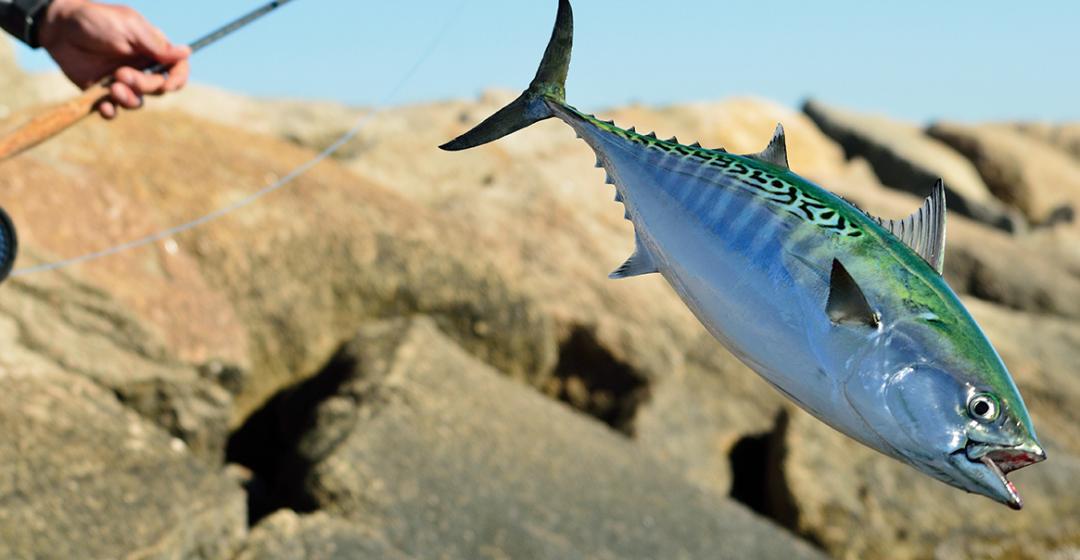More than 4,000 years ago, a human took a hazel shoot about six feet long, to which was attached a horsehair line of about the same length and a bone hook, and caught a fish. It is unlikely any thought to releasing a perfectly good meal entered the fur-clad fisherman’s sloping forehead.
For millennia, fishing was strictly a means to put food on the table. The concept of catch and release as a means to protect fish stocks began to take hold in the latter part of the nineteenth century as fishing entered the wider realm of recreation, due in large part to the influence of prominent fishermen who emphasized the wisdom of releasing a portion of the catch.
Today, catch and release is ingrained in Island fishing culture. No doubt it feels pretty good watching a striped bass swim away. But the mere act of releasing a fish does not ensure its survival – or make one a better person.
The Atlantic States Marine Fisheries Commission (ASMFC), in a May 2019 report on the striped bass stock assessment, said, “The vast majority (85–90 percent) of the annual catch in most years is released alive, and the assessment assumes, based on previous studies, that 9 percent of the fish that are released alive die as a result of being caught.”
The ASMFC reported that 38 million stripers were released in 2017, “3.4 million of which were assumed to have died.”
In a 1989 study of post-release mortality by Paul Diodati of the Massachusetts Division of Marine Fisheries and R. Anne Richards of the National Marine Fisheries Service, 1,015 striped bass were placed in a salt pond impoundment in Salem. Fifty volunteers from local fishing clubs fished over a five-week period using lures, jigs, and bait. Lending weight to the claim that some fishermen couldn’t catch fish in a barrel, only thirty-six of the fishermen accounted for the recorded 281 hook-ups.
Where and how the fish was hooked in the oral cavity (deeply hooked fish did not fare well), use of a single hook or treble, and the experience of the fisherman were factors in catch-and-release mortality, which ranged from 3 percent “under the most favorable conditions” to 26 percent “for the worst set of conditions.” Overall mortality was 9 percent.
Greg Skomal, Massachusetts Division of Marine Fisheries senior fisheries scientist, has studied post-release mortality on tuna and sharks. Other than gear type, he said that studies have shown that the amount of physical trauma outweighs physiological stress as the most significant factor in release mortality for all types of species, including sharks.
“For example, the fish could be hooked in the jaw and doing fine, but that will change dramatically if you yank it out of the water, put your foot on it, and tear the hook out....Water temperature, air exposure, and long fight times can increase physiological stress and impact recovery. Those factors might not kill the fish, but they can weaken it to the extent that it becomes very vulnerable to predation.”
A striped bass hooked and released in June has a better chance of recovering than a fish caught in August. A study by the Maryland Department of Natural Resources of catch-and-release mortality for bass on the state’s popular Susquehanna flats using single-hook lures revealed that water temperature greatly influenced mortality. Larger fish played out and released in water above seventy degrees were particularly at risk.
In 1939, Lee Wulff, one of the most innovative and influential fly-fishermen of his era, said, “Game fish are too valuable to be caught only once.”
Conscientious fisherman can take measures to increase the odds that a fish will survive. Minimizing physical damage and exhaustion are key.
Use circle hooks when fishing bait (now mandated) and single-hook lures. Handle the fish as little as possible to avoid removing its protective slime. Do not hold a fish by its gills. The common practice of holding a large striped bass vertically using a BogaGrip to pose for a photo can damage its jaw and internal organs. It’s better to support the fish under its belly. Get the fish back into the water as soon as possible and give it time to revive.
Of course, the other option is to keep the striper (assuming it falls within the twenty-eight-inch to less than thirty-five-inch slot limit) and eat it.
There are fishermen who express disdain (sometimes bordering on contempt) for those who take a fish. But a fisherman who follows the rules should not feel guilty about putting food on the table.
In Germany and Switzerland a fisherman who releases a fish that meets the minimum size limit faces stiff fines and possible imprisonment. There, catch and release is considered cruel. And the German Animal Welfare Act states that “No-one may cause an animal pain, suffering, or harm without good reason.”
Is fun a good enough reason? Hazel shoot or graphite, it all depends on how you look at it.





